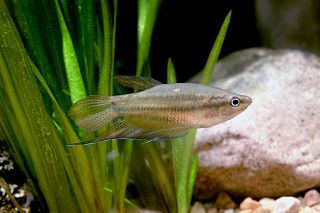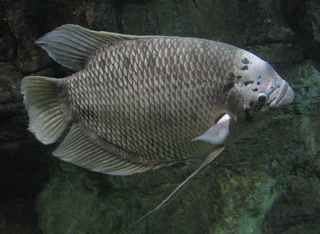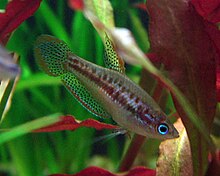
Gouramis, or gouramies, are a group of freshwater anabantiform fish that comprise the family Osphronemidae. The fish are native to Asia—from the Indian Subcontinent to Southeast Asia and northeasterly towards Korea. The name "gourami", of Indonesian origin, is also used for fish of the families Helostomatidae and Anabantidae.

The fork tailed paradisefish, or paradise gourami is a species of gourami found in most types of fresh water in East Asia, ranging from the Korean Peninsula to northern Vietnam. This species can reach a standard length of 6.7 cm, though most are only about 5.5 cm . Paradise gouramis were one of the first ornamental fish available to western aquarium keepers, having been imported 1869 to France by the French aquarium fish importer Pierre Carbonnier in Paris. The paradise fish is one of the more aggressive members of its family. It is more aggressive than the three spot gourami, yet less pugnacious in nature than the less commonly kept combtail.

The croaking gourami is a species of small freshwater labyrinth fish of the gourami family. They are native to still waters in Southeast Asia and are distributed worldwide via the aquarium trade. Croaking gouramis are capable of producing a "croaking" noise using their pectoral fins.

Trichogaster is a genus of gouramis native to South Asia from Pakistan to Myanmar. It is the only genus in the monotypic subfamily Trichogastrinae as set out in the 5th Edition of Fishes of the World, although that book states that there are two genera, the other being Colisa which is treated as a synonym of Trichogaster by Fishbase and the Catalog of Fishes. Fishbase also places the genus in the Luciocephalinae. Species of this genus are very popular in the aquarium trade.

The pygmy gourami, also known as the sparkling gourami, is a freshwater species of gourami native to Southeast Asia.

The Anabantoidei are a suborder of anabantiform ray-finned freshwater fish distinguished by their possession of a lung-like labyrinth organ, which enables them to breathe air. The fish in the Anabantoidei suborder are known as anabantoids or labyrinth fish, or colloquially as gouramies. Some labyrinth fish are important food fish, and many others, such as the Siamese fighting fish and paradise fish, are popular as aquarium fish.

The thick-lipped gourami is a species of gourami native to Southeast Asia, and is a popular aquarium fish.

Belontia, sometimes referred to as combtail gouramis, is a genus of gouramis, the only genus within the subfamily Belontiinae, native to freshwater habitats in Southeast Asia and Sri Lanka. These are medium sized to large gouramis that are seldom kept in aquariums due to their aggression and relative lack of the color common to other gouramis.

Osphronemus is a genus of large gouramis, the only genus within the subfamily Osphroneminae. These fish are known as the giant gouramis and are native to rivers, lakes, pools, swamps and floodplains in Southeast Asia, with O. exodon from the Mekong basin, O. laticlavius and O. septemfasciatus from Borneo, while O. goramy is relatively widespread. O. goramy has been introduced outside its native range in Asia, Africa and Australia.

The snakeskin gourami is a species of gourami native to Southeast Asia. Prior to the merging of Belontidae to the family Osphronemidae, the snakeskin gourami was regarded as the largest member of its family. It is still the largest species in its genus and subfamily.

Trichopodus is a genus of tropical freshwater labyrinth fish of the gourami family found in Southeast Asia. Gouramis of the genus Trichopodus are closely related to those of Trichogaster ; species of both genera have long, thread-like pelvic fins used to sense the environment. However, Trichopodus species have shorter dorsal fin base and, when sexually mature, are much larger, with the largest, the snakeskin gourami, capable of reaching a length of over 8 in (20 cm).

The ornate paradisefish or spotted gourami, is a species of gourami endemic to Sri Lanka. It is the only recognized species in its genus.

Parosphromenus is a genus of gouramies native to freshwater in Southeast Asia. All species are highly specialized peat swamp inhabitants native to southeast Asia, and the males are usually brightly colored in breeding dress; however, their need for soft, acidic water and live food prohibits the genus from becoming popular aquarium fish.

Sphaerichthys is a genus of gouramis native to Southeast Asia known as chocolate gourami. These species live mostly in blackwater rivers/swamps with acidic water. They have dark-light brownish hues with the exception being the female of S. vaillanti which can be dark reddish brown with green-dark blue/black stripes. They are shy fish that are hard to find because of their camouflage which when in action makes them look like a dead leaf floating along the river.

The Macropodusinae are a subfamily of freshwater anabantiform fishes in the gourami family Osphronemidae, which includes the paradisefish, fighting fish and licorice gouramis. Like all members of the family, these are air breathing fishes that frequently inhabit oxygen poor environments hostile to other fishes. They are native to Asia, from Pakistan and India to the Malay Archipelago and north-easterly towards Korea. Many members are common aquarium fish; by far the most famous is the Siamese fighting fish, Betta splendens. Most of the 70+ betta species are paternal mouthbrooders; the remaining members of the subfamily are bubblenesters like most osphronemids.

The giant gourami is a species of large gourami native to freshwater habitats in Southeast Asia. It has also been introduced elsewhere. The species is commercially important as a food fish and is also farmed. It can be found in the aquarium trade, as well. The species has been used for weed control on highly invasive aquatic plants like Salvinia molesta, as the giant gourami can be a voracious herbivore.

The Anabantiformes, collectively known as labyrinth fish, are an order of air-breathing freshwater ray-finned fish with two suborders, five families and having at least 207 species. In addition, some authorities expand the order to include the suborder Nandoidei, which includes three families - the Nandidae, Badidae and Pristolepididae - that appear to be closely related to the Anabantiformes. The order, and these three related families, are part of a monophyletic clade which is a sister clade to the Ovalentaria, the other orders in the clade being Synbranchiformes, Carangiformes, Istiophoriformes and Pleuronectiformes. This clade is sometimes referred to as the Carangaria but is left unnamed and unranked in Fishes of the World. This group of fish are found in Asia and Africa, with some species introduced in United States of America.

The threestripe gourami, also known as the Mekong croaking gourami, is a species of freshwater ray-finned fish from the subfamily Macropodusinae which is part of the gourami family Osphronemidae. It is native to south-east Asia.
Betta kuehnei is a species of gourami. It is native to Asia, where it occurs in Malaysia and Thailand. It is typically found in shallow, shaded forest creeks among aquatic plants such as Cryptocoryne cordata and leaf litter. The water in which the species occurs is clear, with a pH of 7, a hardness of 3 dGH, and a temperature of 25 °C (77 °F). It is known to occur alongside the species Parosphromenus paludicola and Trichopsis vittata. The species reaches 8 cm in total length and is known to be a facultative air-breather. Males of the species exhibit mouthbrooding.
Betta siamorientalis is a species of gourami. It is a freshwater fish native to Asia, where it occurs in shallow marshes, grass fields, and paddy fields in Thailand and Cambodia. It is typically found in still, vegetated environments at the water's edge and is known to use aquatic plants as shelter for building and guarding bubble nests. It is known to occur alongside the species Anabas testudineus, Lepidocephalichthys hasselti, Macrognathus siamensis, Monopterus albus, Pangio anguillaris, Trichopodus trichopterus, Trichopsis pumila, Trichopsis schalleri, and Trichopsis vittata. The species reaches 3.6 cm in standard length and is known to be a facultative air-breather.

















